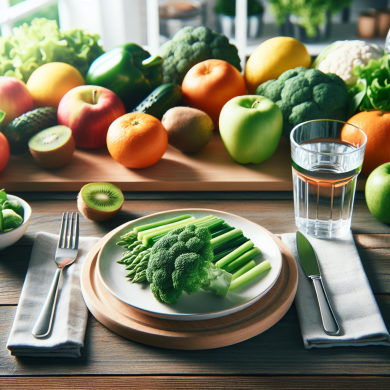Embrace Healthy Fats for a Clean Food Diet
Introduction
In the pursuit of a healthier lifestyle, many people turn to clean eating as a way to nourish their bodies with whole, minimally processed foods. One of the key components of a clean food diet is understanding the role of fats and embracing the right types of fats to support overall health. In this article, we’ll explore the importance of healthy fats, how they fit into a clean food diet, and provide practical tips on incorporating them into your meals.
The Importance of Fats in a Diet
Fats have long been misunderstood and often vilified in the context of diet and nutrition. However, fats are one of the three essential macronutrients, alongside carbohydrates and proteins, that our bodies need to function optimally. They play a crucial role in numerous bodily processes, including hormone production, cell membrane integrity, nutrient absorption, and energy storage.
Types of Fats
Not all fats are created equal. Understanding the different types of fats can help you make informed choices that align with a clean food diet.
Saturated Fats
Saturated fats are typically solid at room temperature and are found in animal products such as meat, butter, and cheese, as well as tropical oils like coconut oil. While they have been linked to increased cholesterol levels and heart disease in the past, recent studies suggest that they may not be as harmful as once thought when consumed in moderation.
Unsaturated Fats
Unsaturated fats are considered heart-healthy and are primarily found in plant-based oils, nuts, seeds, and fatty fish. There are two main types of unsaturated fats:
Monounsaturated Fats
These fats are known for their ability to improve cholesterol levels and are found in foods such as olive oil, avocados, and nuts like almonds and cashews.
Polyunsaturated Fats
Polyunsaturated fats include omega-3 and omega-6 fatty acids, which are essential for brain function and cell growth. Sources include fatty fish like salmon, flaxseeds, walnuts, and sunflower oil.
Trans Fats
Trans fats are artificially created through the process of hydrogenation, which turns liquid oils into solid fats. They are commonly found in processed foods, baked goods, and margarine. Trans fats should be avoided as they are associated with an increased risk of heart disease, inflammation, and other health issues.
The Role of Healthy Fats in a Clean Food Diet
A clean food diet emphasizes whole, unprocessed foods and encourages the consumption of healthy fats in their natural forms. Here are some reasons why healthy fats should be embraced as part of a clean food diet:
1. Energy Source
Healthy fats provide a concentrated source of energy, making them an essential part of a balanced diet. Unlike carbohydrates, which provide quick energy, fats offer sustained energy that helps keep you feeling fuller for longer periods.
2. Nutrient Absorption
Certain vitamins, such as A, D, E, and K, are fat-soluble, meaning they require dietary fat for absorption. Including healthy fats in your meals ensures that your body can effectively absorb these essential nutrients.
3. Brain Health
Omega-3 fatty acids, found in fatty fish and other sources, are vital for brain health. They support cognitive function, memory, and mood regulation, making them an essential component of a clean food diet.
4. Heart Health
Monounsaturated and polyunsaturated fats have been shown to improve cardiovascular health by reducing bad cholesterol levels and increasing good cholesterol. Incorporating these fats into your diet can help lower the risk of heart disease.
5. Inflammation Reduction
Omega-3 fatty acids also have anti-inflammatory properties, which can help reduce inflammation in the body. Chronic inflammation is linked to various diseases, including arthritis, diabetes, and certain cancers.
Incorporating Healthy Fats into Your Clean Food Diet
Here are some practical tips for incorporating healthy fats into your clean food diet:
1. Choose the Right Oils
Opt for oils that are rich in monounsaturated and polyunsaturated fats, such as olive oil, avocado oil, and flaxseed oil. Use them for cooking, salad dressings, and drizzling over dishes to enhance flavor and nutrition.
2. Enjoy Fatty Fish
Include fatty fish like salmon, mackerel, and sardines in your diet at least twice a week. These fish are excellent sources of omega-3 fatty acids and provide numerous health benefits.
3. Snack on Nuts and Seeds
Nuts and seeds are convenient, nutrient-dense snacks that offer a healthy dose of fats, protein, and fiber. Almonds, walnuts, chia seeds, and flaxseeds are great options to keep on hand for a satisfying snack.
4. Incorporate Avocados
Avocados are a versatile and delicious source of monounsaturated fats. Add them to salads, smoothies, or toast for a creamy texture and a boost of healthy fats.
5. Limit Processed Foods
Minimize the consumption of processed foods high in trans fats, such as commercially baked goods, fried foods, and margarine. Instead, focus on whole, natural foods to ensure you’re getting the best quality fats.
Conclusion
Embracing healthy fats as part of a clean food diet is a key step toward achieving optimal health. By understanding the different types of fats and their roles in the body, you can make informed choices that support your overall well-being. Remember to prioritize whole, unprocessed foods rich in monounsaturated and polyunsaturated fats, and enjoy the benefits they bring to your energy levels, nutrient absorption, brain and heart health, and more. By doing so, you’ll be well on your way to a balanced and nourishing clean food diet.















Add comment